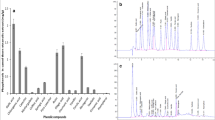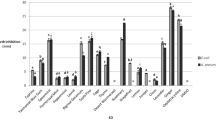Abstract
The antimicrobial effects of aqueous extracts prepared by different extraction methods on important food-borne zoonotic bacteria (Klebsiella pneumoniae (ATCC700603), Campylobacter jejuni (ATTC 33,560), Salmonella Paratyphi A (NCTC13), Staphylococcus aureus (ATCC29213), and Enterococcus faecalis (ATCC29212)) were investigated. The bioactive components of aqueous garlic extract (GE) and aqueous garlic extract with particles (GEP) were analysed with solid-phase microextraction-gas chromatography mass spectrometry (SPME/GC–MS) system. The antimicrobial effect of GE and GEP were determined using agar well diffusion method, minimum inhibitory concentration (MIC) and minimum bactericidal concentration (MBC), and time-kill assay. The results showed there were two main components in GE and GEP, namely, diallyl disulphide (46.83% vs. 41.77%), and allyl trisulfide/trisulfide di-2-propenyl (20.81% vs. 19.74%). The data obtained from inhibition zone assay statistically indicated that GEP exhibited a higher antibacterial effect against Campylobacter jejuni and Salmonella Paratyphi A with zone diameters of 34.00 ± 0.82 and 34.50 ± 0.84, respectively (p < 0.05). GEP and GE showed more effective inhibitory effect on Gram positive E. faecalis with the MIC and MBC values of 50 mg/ml. S. aureus had high sensitivity as the lower concentration (< 50 mg/ml) of GEP was needed for its growth inhibition. All bacterial cells tested in the killing assay were reduced to remarkable levels within 3, 6, and 9 h after interacting with GEP and fully lost viability within 24 h. The study revealed that aqueous garlic extracts especially the particulate form were a very strong antimicrobial agent for overcoming food pathogens due to their bioactive substances.
Graphical abstract



Similar content being viewed by others
Data availability
The datasets are available from the corresponding author on reasonable request.
References
Bantawa K, Rai K, Subba Limbu D, Khanal H (2018) Food-borne bacterial pathogens in marketed raw meat of Dharan, eastern Nepal. BMC Res Notes 11(1):1–5
Yazgan H (2020) Investigation of antimicrobial properties of sage essential oil and its nanoemulsion as antimicrobial agent. LWT 130:109669
Hsouna AB, Trigui M, Mansour RB, Jarraya RM, Damak M, Jaoua S (2011) Chemical composition, cytotoxicity effect and antimicrobial activity of Ceratonia siliqua essential oil with preservative effects against Listeria inoculated in minced beef meat. Int J Food Microbiol 148(1):66–72
Mahmoudzadeh M, Hosseini H, Shahraz F, Akhondzadeh‐Basti A, Khaneghah AM, Azizkhani M, ... Mahmoudzadeh L (2017) Essential oil composition and antioxidant capacity of Carum copticum and its antibacterial effect on Staphylococcus aureus, Enterococcus faecalis and Escherichia coli O157: H7. J. Food Process Preserv 41(3):e12938
Rahman A, Kang SC (2009) In vitro control of food-borne and food spoilage bacteria by essential oil and ethanol extracts of Lonicera japonica Thunb. Food Chem 116(3):670–675
Zhang Y, Liu X, Wang Y, Jiang P, Quek S (2016) Antibacterial activity and mechanism of cinnamon essential oil against Escherichia coli and Staphylococcus aureus. Food Control 59:282–289
Addis M, Sisay D (2015) A review on major food borne bacterial illnesses. J Trop Dis Public Health 3(4):1–7
Abebe E, Gugsa G, Ahmed M (2020) Review on major food-borne zoonotic bacterial pathogens. J Trop Med 2020:1–19
Davidson PM, Doan C (2020) Natamycin. In: Michael Davidson P, Matthew Taylor T, David JRD (eds) Antimicrobials in Food, 4th edn. CRC Press, USA, pp 339–356
Bocate KP, Evangelista AG, Luciano FB (2021) Garlic essential oil as an antifungal and anti-mycotoxin agent in stored corn. LWT 147:111600
Khalili Sadaghiani S, Aliakbarlu J, Tajik H, Mahmoudian A (2019) Anti-listeria activity and shelf life extension effects of Lactobacillus along with garlic extract in ground beef. J Food Saf 39(6):e12709
Zhu Y, Anand R, Geng X, Ding Y (2018) A mini review: garlic extract and vascular diseases. Neurol Res 40(6):421–425
Diao X, Huan Y, Chitrakar B (2020) Extending the shelf life of ready-to-eat spiced chicken meat: garlic aqueous extracts-carboxymethyl chitosan ultrasonicated coating solution. Food Bioprocess Tech 13(5):786–796
Michalak I, Górka B, Wieczorek PP, Rój E, Lipok J, Łęska B, ... Chojnacka K (2016) Supercritical fluid extraction of algae enhances levels of biologically active compounds promoting plant growth. Eur J Phycol 51(3):243-252
Chen C, Liu CH, Cai J, Zhang W, Qi WL, Wang Z, ... Yang Y (2018) Broad-spectrum antimicrobial activity, chemical composition and mechanism of action of garlic (Allium sativum) extracts. Food Control 86:117–125
El-Sayed HS, Chizzola R, Ramadan AA, Edris AE (2017) Chemical composition and antimicrobial activity of garlic essential oils evaluated in organic solvent, emulsifying, and self-microemulsifying water-based delivery systems. Food Chem 221:196–204
Li WR, Shi QS, Dai HQ, Liang Q, Xie XB, Huang XM, ... Zhang LX (2016) Antifungal activity, kinetics and molecular mechanism of action of garlic oil against Candida albicans. Sci Rep 6(1):1–9
Yazgan H, Kuley E, Güven Gökmen T, Regenstein JM, Özogul F (2021) The antimicrobial properties and biogenic amine production of lactic acid bacteria isolated from various fermented food products. J Food Process Preserv 45(1):e15085
Yazgan H (2022) Antimicrobial activities of emulsion-based edible solutions incorporating lemon essential oil and sodium caseinate against some food-borne bacteria. J Food Sci Technol 59(12):4695–4705
Abdou ES, Galhoum GF, Mohamed EN (2018) Curcumin loaded nanoemulsions/pectin coatings for refrigerated chicken fillets. Food Hydrocoll 83:445–453
Mnayer D, Fabiano-Tixier AS, Petitcolas E, Hamieh T, Nehme N, Ferrant C, ... Chemat F (2014) Chemical composition, antibacterial and antioxidant activities of six essentials oils from the Alliaceae family. Mol 19(12):20034–20053
Corzomartinez M, Corzo N, Villamiel M (2007) Biological properties of onions and garlic. Trends Food Sci Technol 18:609–625
Rattanachaikunsopon P, Phumkhachorn P (2008) Diallyl sulfide content and antimicrobial activity against food-borne pathogenis bacteria of chives (Allium schoenoprasum) Bionsci. Biotechnol Biochem 72:2987–2991
Ismail RM, Saleh AHA, Ali KS (2020) GC-MS analysis and antibacterial activity of garlic extract with antibiotic. J Med Plants Stud 8(1):26–30
Tchorzewska D, Bocianowski J, Najda A, Dąbrowska A, Winiarczyk K (2017) Effect of environment fluctuations on biomass and allicin level in Allium sativum (cv. Harnas, Arkus) and Allium ampeloprasum var. ampeloprasum (GHG-L). J Appl Bot Food Qual 90:106–114
Marsic NK, Necemer M, Veberic R, Ulrih NP, Skrt M (2019) Effect of cultivar and fertilization on garlic yield and allicin content in bulbs at harvest and during storage. Turk J Agric Forest 43(4):414–429
Angane M, Swift S, Huang K, Butts CA, Quek SY (2022) Essential oils and their major components: an updated review on antimicrobial activities, mechanism of action and their potential application in the food Industry. Foods 11(3):464
Abidullah M, Jadhav P, Sujan SS, Shrimanikandan AG, Reddy CR, Wasan RK (2021) Potential antibacterial efficacy of garlic extract on Staphylococcus aureus, Escherichia coli, and Klebsiella pneumoniae: an in vitro study. J Pharm Bioallied Sci 13(Suppl 1):S590
Liaqat A, Zahoor T, Atif Randhawa M, Shahid M (2019) Characterization and antimicrobial potential of bioactive components of sonicated extract from garlic (Allium sativum) against foodborne pathogens. J Food Process Preserv 43(5):e13936
Anees AM, Ravi S, Ghogare P (2015) Studies on antimicrobial activity of spices and effect of temperature and pH on its antimicrobial properties. IOSR J Pharm Biol Sci 10(1):99–102
Siddique R, Anjaneyulu K, Muralidharan NP (2019) Antimicrobial efficacy of garlic-lemon in comparison with sodium hypochlorite against E. faecalis. J Clin Diagn Res 13(1):55–58
Natasya-Ain R, Eirna-Liza N, Jasmin MY, Karim M (2018) Antibacterial activity of garlic extracts on fish pathogenic bacteria. J Environ Biol 39(5):808–812
Tijjani A, Musa DD, Aliyu Y (2017) Antibacterial activity of garlic (Allium sativum) on Staphylococcus aureus and Escherichia coli. Int J Curr Sci Stud 1:1410–1703
Njue L, Kanja LW, Ombui JN, Nduhiu JG, Obiero D (2014) Efficacy of antimicrobial activity of garlic extracts on bacterial pathogens commonly found to contaminate meat. East Afr Med J 91(12):442–448
Haghkhah M, Ghaemi EA (2022) Phytochemical analysis of garlic hydro-alcoholic extract and evaluation of its anti-bacterial effect on enterohemorrhagic Escherichia coli in Vitro and ex Vivo. Med Lab J 16(1):25–31
Ryssel H, Kloeters O, Germann G, Schäfer T, Wiedemann G, Oehlbauer M (2009) The antimicrobial effect of acetic acid—an alternative to common local antiseptics? Burns 35(5):695–700
Funding
This research was financed by the Scientific Research Projects of Cukurova University (BAP), Project number; TSA-2021–13822.
Author information
Authors and Affiliations
Contributions
Hatice Yazgan: original draft preparation, software (microbiological and statistical analyses), writing. Esmeray Kuley: software (microbiological and chemical analysis). Yesim Özogul: conceptualization and editing.
Corresponding author
Ethics declarations
Ethical approval
This paper does not conduct research on humans or animals.
Competing interest
The authors declare no competing interests.
Additional information
Publisher's note
Springer Nature remains neutral with regard to jurisdictional claims in published maps and institutional affiliations.
Rights and permissions
Springer Nature or its licensor (e.g. a society or other partner) holds exclusive rights to this article under a publishing agreement with the author(s) or other rightsholder(s); author self-archiving of the accepted manuscript version of this article is solely governed by the terms of such publishing agreement and applicable law.
About this article
Cite this article
Yazgan, H., Kuley, E. & Özogul, Y. Investigation of bioactive compounds and antimicrobial properties of aqueous garlic extracts on important food-borne zoonotic bacteria for food applications. Biomass Conv. Bioref. (2022). https://doi.org/10.1007/s13399-022-03625-4
Received:
Revised:
Accepted:
Published:
DOI: https://doi.org/10.1007/s13399-022-03625-4




